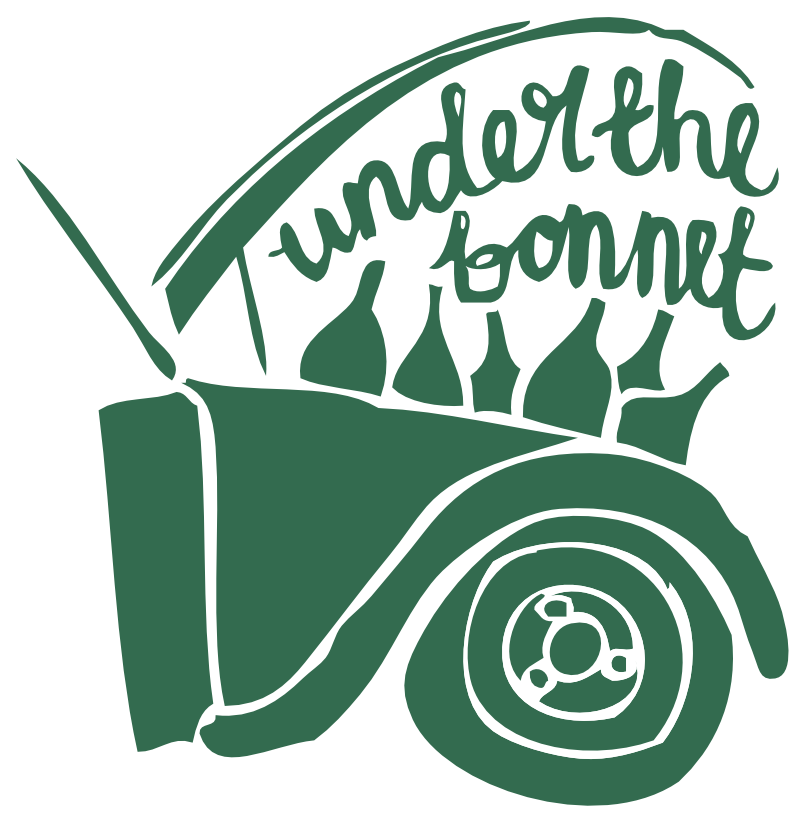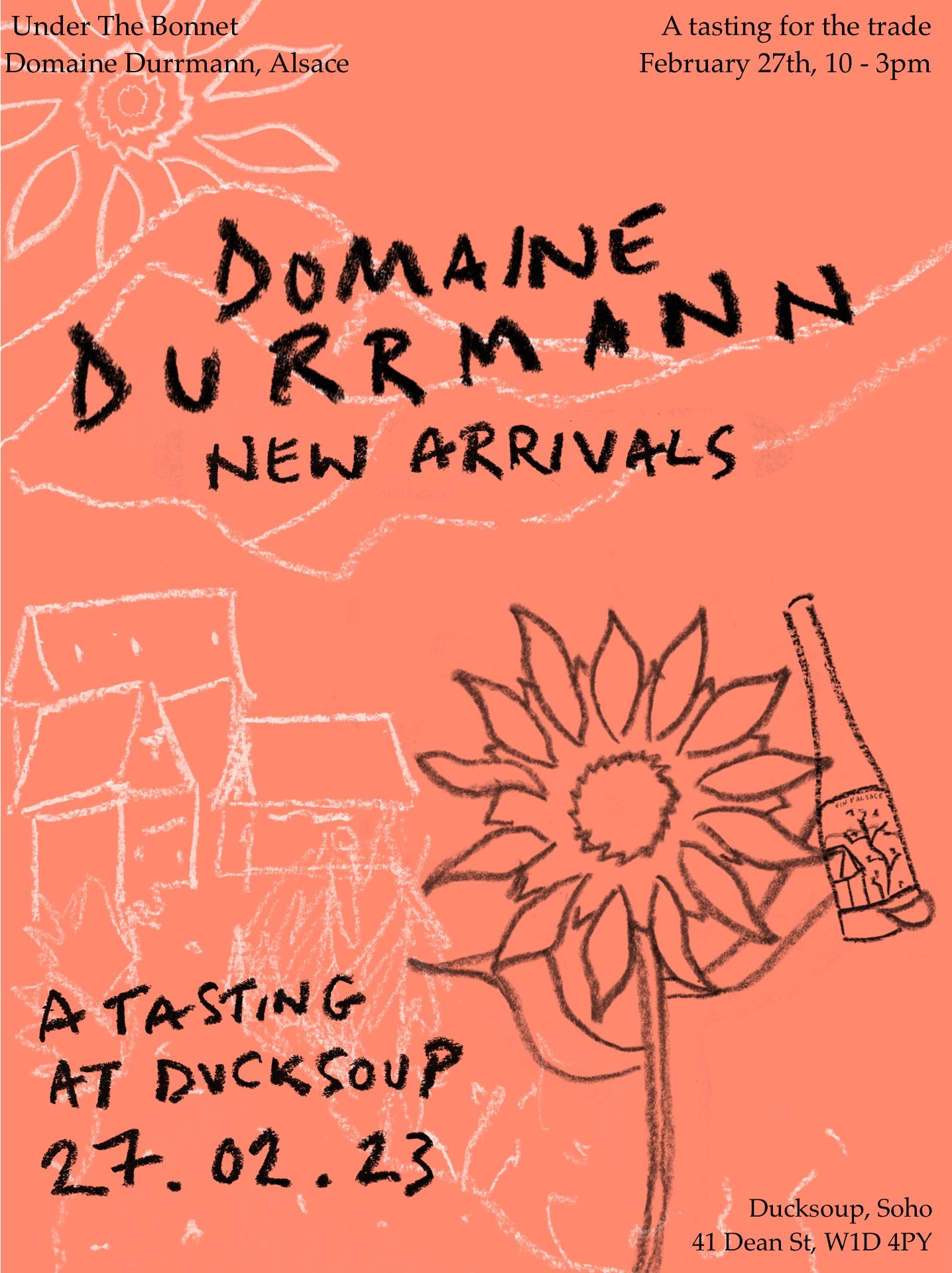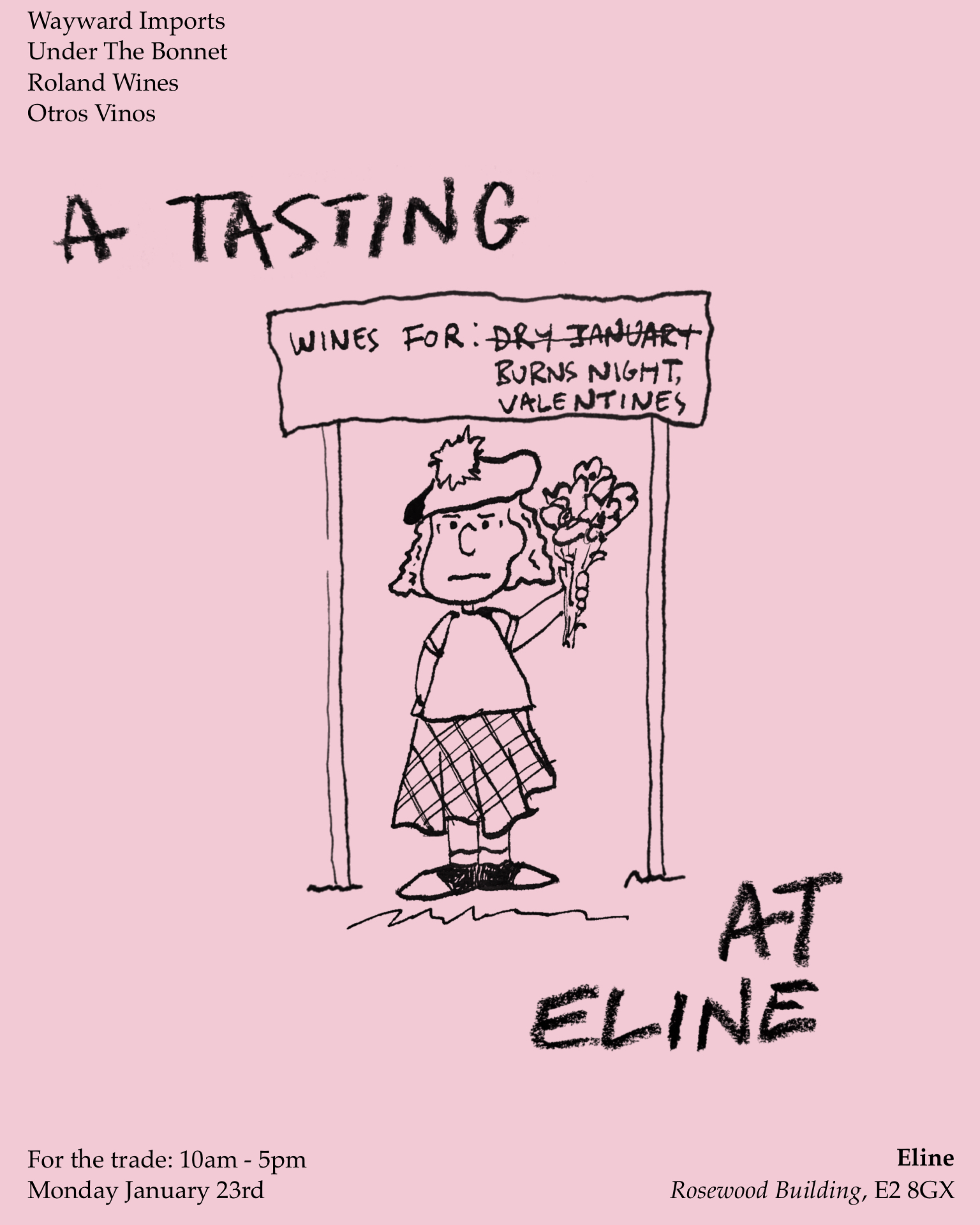A tasting for the trade, on April 3rd we’ll be at the lovely Eline in Hoxton to pour a host of new arrivals and bright wines perfect for the blossoms popping.
Read moreReal Wine In The Vines
On Tuesday 16th May, we'll be travelling to Newbarn Farm for the first ever Real Wine In The Vines, joined by our British winemakers. A tasting for the trade.
Read moreA Cab-Franc Calling: Clos Kixhaya
Committed to working simply with what they have, Béa & Etienne at Clos Kixhaya have proved very resourceful in making the most of their four hectares of Cab Franc. The latest release to show another side to this versatile grape is picked from their oldest vines, up to 90 years in age.
Read moreTalking About Regeneration: A Conversation with Jonas Brand
On regular calls with Jonas Brand, ostensibly to get information about upcoming releases, the conversation often enough falls down the ever-inspiring wormhole of his and Daniel's approach to farming. It's hard to leave a conversation with Jonas not feeling optimistic about the future, and charged with ideas.
With the release of their 2021 Pinot Noir and Monastery Riesling, we thought it would be a nice opportunity to print a full conversation with Jonas about regenerative agriculture, as a bit of an introduction to the term, and a deeper dive for those interested. Photographs by the Brand Brother's talented friend Holger Riegel.
UTB: Hey Jonas! I really like the fact that you have a method you stick to for making each of the wines now. As followers of yours and Daniels journey, it's great to know that the only thing really changing year to year is the weather, and to a certain extent the agriculture. How did you decide to work in the way that's since come to be called Regenerative Agriculture?
Jonas: Exactly, the wines we've made more or less the same way for a while now. We know how we want to capture each variety or parcel. But it's the farming that evolves, and I find that very exciting. Sure, we'll make small adaptations if something major changes, to be careful with tannic extractions and such. But more or less, we stick to our plan!
When we started with the viticulture, we knew we wanted to work organically. That was important, but it was not our idea to work regeneratively straight away. That was something that has developed naturally and slowly, reading and comparing ideas with other growers. It dawned on us it was the way we wanted to grow.
When we began, the term wasn't even used very much. But, for me it's a good term, it really sums up what we're all trying to achieve. Building up soil fertility and health, and trying by all means to not deplete it!
The scary thing is that, most soils on our planet are degrading soils. Farmland is getting worse, but luckily there's a way out. Plants can thrive if we let them, if we don't force them. We can use the natural balance of an area to increase fertility in the soils, and we end up with more nutrients.
When we started organic, we did the classic thing everyone does when they come out of school. You till once, sow a cover crop, it grows nicely, you mow it because you're worried it's competition for the vines... maybe let it grow again, then you till again, or till the next row... working so hard to have an idea of this pretty aspect of farming, a kind of forced diversity, lots of flowers... but, where does nature work like that? Nature doesn't work like that!
Nature is a few flowering plants here and there, grasses, legumes, real diversity, and chaos! Some of these plants need more than a year to establish. To be mowing, tilling, re-sowing, it's such a waste of seed, and energy. Of course, you might need to do this at the beginning to get a solid base, but you should let nature guide it from there.
So once we came to that realisation; that's what we did, let nature be the guide. You can do this system for a long time: truly not interfering, not opening the soil. We've been able to do that for the last six years.
Now, the speed of things is slowing, so it's time to look at how to use other the seasons. I'd really like to know how to use the wet winters here better, to do direct-seeding (seeding directly into the soil without breaking the soil) of winter grains into the rows of vines. That way the winter grains can build up organic matter for the year ahead whilst the vines are dormant. That's something I've been experimenting with, seeding rows of vines with oats.
In spring, our natural cover crop just jumps up, there's lots of grasses, lots of clover to fixate nitrogen. It's very diverse, but only grows when there's more warmth. The spring cover and the summer cover I love because they grow naturally, lots of crown-vetch and yarrow. Lots of local plants really, that grow so much over the warm seasons.
We roller crimp them, to mimic animals walking. This way the plant thinks it's dying and re-seeds itself. From that crimped part of the plant new shoots grow, and we have 10-15 cm of mulch layers, so the soil is always covered in our vineyards.
We'd love to work exclusively with animals, rather than tractors. But we have quite a lot of land, and it's really important to us to make affordable wines, that many people can drink. So we use a some modern techniques - which I don't think is a bad thing. As long as soil health and fertility aren't compromised.
For me, it all comes back to protecting the soil. Plants reseeding themselves, animals walking over it, forcing it to grow; things we can mimic a bit by ourselves. Like this, we build up so much soil fertility that we never need compost.
So, out of our 17 plots: just 7 will get a little compost tomorrow, some that are young, or some that we've taken over recently - basically the ones that haven't established this system yet.
In our plots where we've worked this way for the longest, the nutrition is huge. For example, many growers put their grape pomace back into the vineyards. I can add it to the youngest ones, but in most of ours it would create over-fertility. That for me is regenerating the land: we've created excess nutrition!
When I worked with James Erskine in Australia, we'd feed it to the cows. They love it. There's a farmer in town that I can give it to now we have an excess, in return we can get manure for younger vineyards. We're always finding ways to close these loops.
You sent me the picture of that super-sized clover in your vineyards when you were shoot-thinning over summer, it's such a simple illustration of how much vigour there is in your vineyards now, these things growing way beyond the size we'd normally find. You can absolutely feel that energy in the wines.
You've also started farming grain recently, harvesting 400 kilos of mixed wheat populations - how did you decide to start growing wheat?
There's a few reasons why we started with agriculture again. The first is this is how the farm used to be with my grandma and grandpa: mixed agriculture with grains, fields - the wine was the smallest part. So, we still have that farmland. We never sold the fields, just leased them out to other farmers who were working more conventionally. But then I started thinking about regenerating the land, worrying about climate change.
I felt like our family's land was out there with degrading soil, and it could be used instead to help fight climate change. It's just 4 or 5 hectares, but we can help set examples for other growers in the area, other people who are paying attention to what we do because we're wine growers.
In lockdown, I got really into researching direct-seeding in the vineyards, and that pulled me back into agriculture. It all got me onto farming in the general sense. With vineyards, it's easy to regenerate the land, because you essentially have rows of little trees with roots that go very deep, and then lots of space that you can regenerate the top-soil with organic matter.
I got really deep into agroforestry, thinking about trees in fields - the landscape in our area is so fucking poor. On our side of the valley there's no trees, just agricultural farmland. So I had the idea to create more diversity, and hopefully make it nicer. But planting trees without purpose is really difficult because the land is expensive. So on these 5 hectares we decided to do mixed agriculture whilst also planting trees.
Over the first few years, the trees won't make any shade or combat nutrients, and I can grow grain in between. But in 20 years we might need to look at the system differently, because the trees will have established. The orchard we planted is 30 different fruit trees, peaches, apples, quince, mirabelle plums, we'll hopefully make a mixed-fruit cider from it.
I really love that the project is growing from a family winery, into a very holistic approach with so many strands that will develop over the next few years. That must link in with the local community, and your connections to other producers in the area.
We have these connections with restaurants, and a local bakery, that creates so much possibility. The baker at Pankratiushof has agreed to take all my yields of grain which is exciting. Eventually we'll have fruit, cider, wine of course, grain, potatoes. It's super nice for us, and for our team. Our employees and our family will have first picks and then what's left we can sell.
I think it helps build a greater sense of community, in our team but also in our village. There will be a price list for locals so they can get really amazing products for less than they would pay in the supermarket. We can sell directly to people, directly to restaurants, and hopefully give people really nice products for nice prices.
I'm really excited to be having these conversations with people in the area and further: because we have wine as a platform to have these conversations. For some reason, people are listening to winemakers. It would be amazing for a grain farmer to have the same platform as a winemaker, maybe soon they will. But for now; I have this platform, so I can tell everyone about grain, about the possibility you have with regenerating the land!
It's been really interesting developing this project, and really cool. My wife Pauline is supporting me big time with this, with calculating and planning; it's been amazing to have something to work on together. It's turning into something very beautiful. My parents gave us the possibility that we could even do something like this, but of course its eating into our time schedule! My dad is always thinking with my ideas: "not another crazy idea Jonas!" But he always sees the benefits... he comes round eventually!
New Arrivals: Brand Brothers 2021
The 2021 editions of Riesling Monastery and Pinot Noir Pur are available now, and tasting brilliant despite a battle of a harvest.
Read moreI'm Your Yann - Durrmann Lands
Re-stocks and new cuvees from Domaine Durrmann are here: vibrant and alive wines from a troublesome vintage.
Read moreDurrmann Incoming
Next week, new arrivals land from Yann Durrmann. To celebrate, we’re opening the lot to taste at Ducksoup on 27.02.23
Read more& The Caravan Passes - New Philippe Delmee
It's always a treat to have wines arrive from our man in Faye d'Anjou: Philippe Delmee. Among them, the exciting return of his brilliantly live & direct Chenin: 'Les Ch'nins on boit, Et la caravane passe' (after what must be at least a three-year gap)
Read moreFrom a Little Thing to Another Thing: New Anjou
In 2022 Corentin Le Bolloch's micro-vigneron project Les P'Tites Choses became a family domaine with the addition of another six hectares and a new winery, becoming Autre Chose. We're pleased to make available some of the last P'Tites Choses releases, and caught up with Corentin to learn about the next chapter.
Read moreYou'd Better Like Chenin! (And Grolleau, and Cab Franc) : Domaine Melaric
Working a surface of just under five hectares over Tuffeau and Silex, the wines of Domaine Melaric continue to be a profound demonstration of the possibilities available at this southern-tip of Saumur. We have a handful of new arrivals from Melanie & Aymeric available now from their 2020 vintage.
Read moreGoing Underground: New from L'Austral
It's been a while since we've been able to release new wines from Pauline & Laurent at L'Austral, so we're thrilled to finally have available their supple expressions of Cab-Franc and detailed, chiselled Chenin from Saumur Puy-Notre-Dame.
Read moreIt Takes A Village: Introducing Ori Vin
A labour of love, completed with utmost dedication and the hugely-appreciated support of family & friends; Oriane Rosner’s first vintage is a brilliantly bright, dynamic expression of Gaillac. Available now, we’re thrilled to be introducing Oriane and her wines to the family.
Read moreA Tasting at Eline
Our first trade tasting of 2023, at Hoxton’s beautiful new restaurant, Eline
Read moreSail To The Moon: The Pristine St Joseph of Jean Delobre
We’ve just received a tranche of arrivals from the iconic La Ferme Des Sept Lunes, here’s what we have available,
Read moreA Visit to Domaine Balansa
Last March we visited Celine & Alex at Domaine Balansa to rattle around the schist hills of the Hautes Corbières. With new wines arriving from them, it seemed like a good time to look back on the trip.
Read moreWeigand Week!
Next week, we’re pleased to welcome Andi Weigand to the UK for his first trip since we brought him under our nominal bonnet in the wilds of 2020. Two events to celebrate Andi and his wines in London & Manchester!
Read moreOne Last Trade Tasting Before Christmas
All sorts landing at the arch at the moment, so we decided to squeeze in one last trade tasting before Christmas.
Read moreUnder The Skin at Petit Oratoire
Three new arrivals Lori Haon, including a one-off cuvee from his secret garden of buried Georgian qvevri.
Read moreA Dinner With Konni (&Evi in Spirit)
With the arrival of Konni in the UK next week, we’re incredibly pleased to host a dinner alongside our friends at Juliet’s to celebrate his & Evi’s brilliantly precise and alive wines.
Read moreNouveau est Arrivé!
The first wines of 2022 have landed thanks to Mathilde & Sylvere at Séléné. Santé!
Read more


















